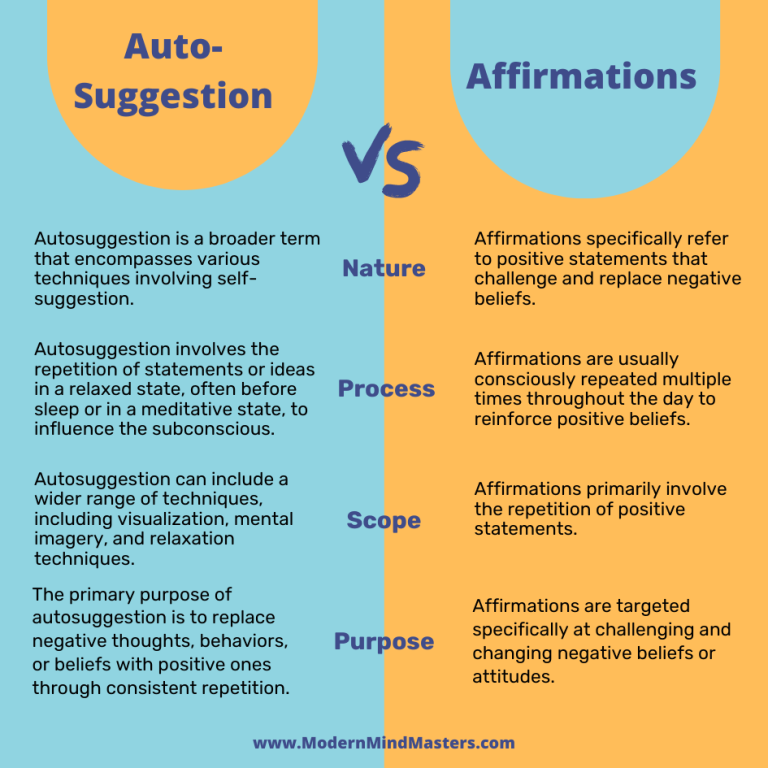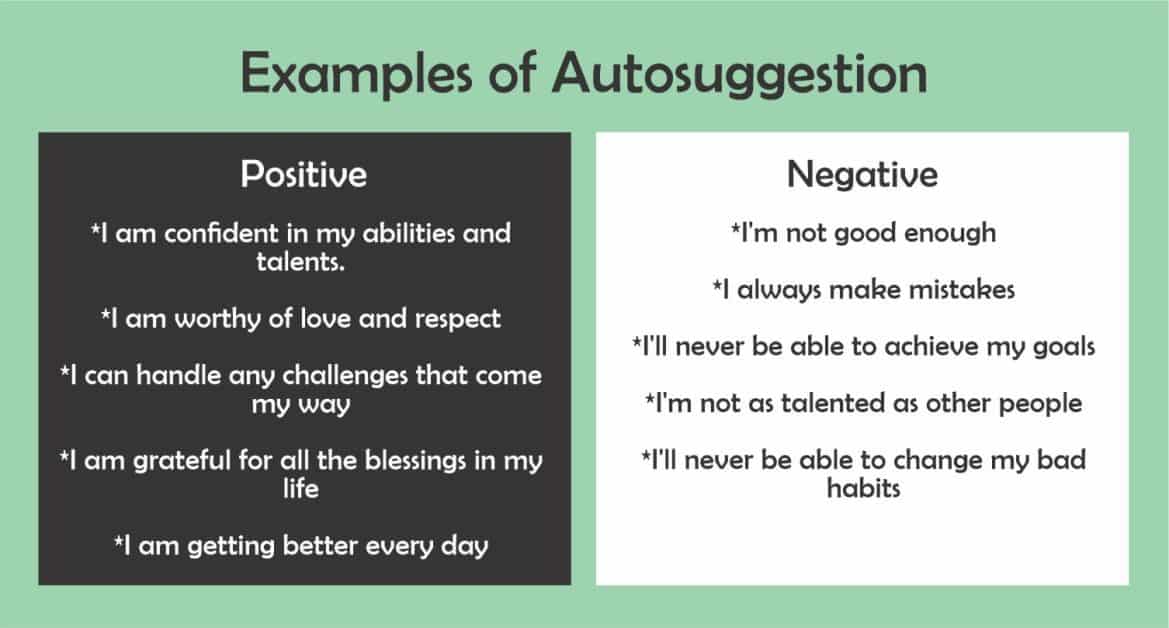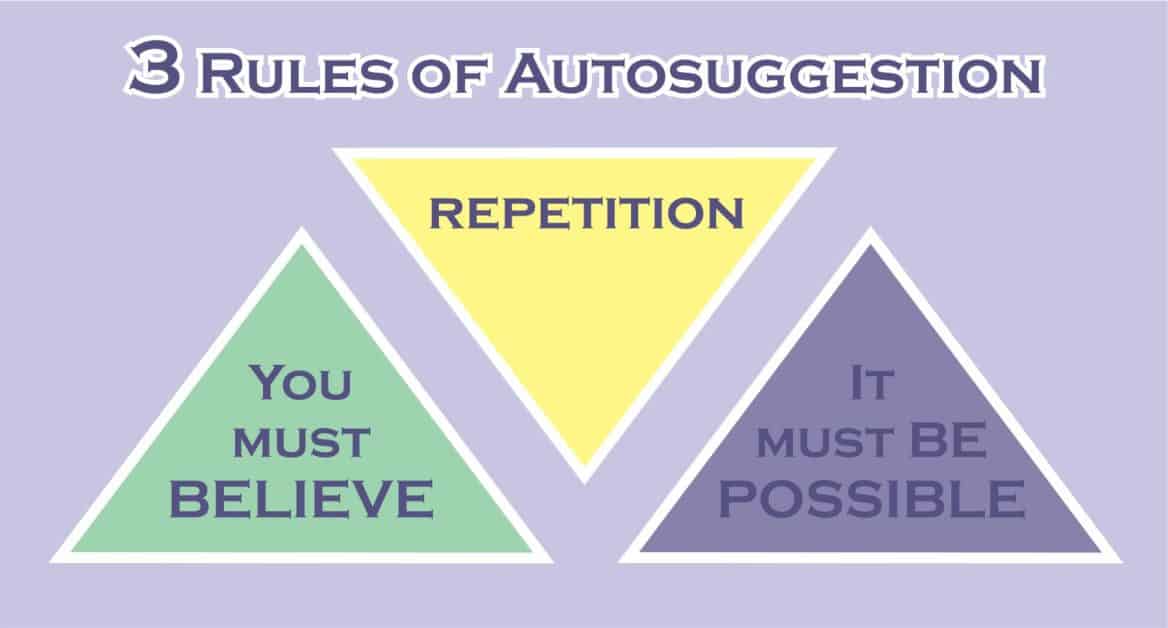Are you looking to get ahead in life without actually doing anything? Welcome to the wonderful world of autosuggestion, where you can trick your mind into thinking you’re successful and hope that the universe doesn’t catch on!
No, not really of course, but autosuggestion, the process of using positive self-talk and mental imagery to influence the subconscious mind and bring about desired changes in behavior or thought patterns, is about as close as we can realistically get.
While difficult to estimate accurately, scientists generally believe that we have only scratched the surface of understanding the brain and its functions: estimates state that we may know about 10-20% of the brain’s total function, while others believe it could be even less.
While many ascribe positive affirmations as merely wishful thinking (which is often true as we will see), you have likely indirectly witnessed this phenomenon through subconscious processes such as the placebo effect.
This article will delve into the deep and mysterious realm of autosuggestion, the current scientific consensus surrounding it, and how you can take advantage of its powerful effects to instill tangible and physical change in your body and mind.
What is Autosuggestion?
Autosuggestion is the ability to induce real physical change (good or bad) using the self-managed power of thought and belief. Typically this involves positive affirmations and self-talk to influence your thoughts, feelings, and behaviors.
What is the Difference Between Autosuggestion and Affirmations?
Autosuggestion is a broader term that encompasses various techniques involving self-suggestion, while affirmations specifically refer to positive statements that challenge and replace negative beliefs.
Whereas affirmations are limited to the repetition of positive statements, autosuggestion involves the repetition of statements or ideas in a relaxed state, often before sleep or in a meditative state, to influence the subconscious. It can also include a wider range of techniques, including visualization, mental imagery, and relaxation techniques.

How Can Autosuggestion Affect Mental Health and Boost Self-Confidence?
Although autosuggestion has been shunned by scientific communities since its inception for its lack of empirical testability, a growing interest in research has taken place in recent years due to recent revelations of the neural changes occurring during autosuggestive testing.
Fardo and colleagues found in this study that perceived pain in the forearm was reduced when the participants imagined a glove covering the forearm as measured by modulations in pain-related potentials with electroencephalography (EEG).
Conversely, an increase in pain perception was found when these same test participants were asked to imagine a lesion on their arm.
Experiments such as these show how self-suggested thoughts can directly influence one’s physical status; in this case, simply imagining an injury on the forearm was enough to change neural activity.
Findings such as these arouse great interest in the potential use of autosuggestion to boost physical health and reduce detrimental afflictions.
Autosuggestion in Action
Imagine applying this physical change to beneficial endeavors. What if you could recover from colds and flu faster by priming your mind to heal quickly? What if you could boost the output strength of your muscles by believing yourself to be strong?
Psychogenic pain (though the term is outdated professionally) is a phenomenon where a person suffers very real and debilitating pain that stems from neurological processing, despite there being no physical reason for it.
If we could understand and utilize the neurological processes occurring during autosuggestion, we might be able to rewire the brain through the power of self-suggestion to overcome such debilitating afflictions.
Types of Autosuggestion – Spontaneous and Reflective
Émile Coué, a pioneer of autosuggestion in the early 1900s, identified two types of self-suggestion.
The first, which he named spontaneous autosuggestion, occurs naturally without conscious effort. It is the natural effect of how our environment influences our subconscious thoughts, such as past traumatic memories stored in the unconscious, and how continually repeated negative observations soon become our new normal.
Related Article: Learned Helplessness
Before the age of seven, a child’s subconscious state is in constant autosuggestion. Their subconscious perceptions of their environments set their character and beliefs. They cannot fight negative perceptions as we can as adults because they have not yet formed their subconscious beliefs of right and wrong and cannot distinguish between them.
The second type of autosuggestion, reflective, is intentional and deliberately induced through conscious effort. This was the version of most interest to Coué because, if successfully applied, it suggests that we can actively influence our subconscious thoughts and values.

What is the purpose of Autosuggestion?
It is important to note that many subconscious beliefs are established for good reason. When crossing the street while looking at your phone, and are almost struck by a vehicle, you may feel stupid, guilty, and embarrassed.
Good. Your subconscious needs this information to learn that it feels terrible and you should not do it again. But our subconscious cannot distinguish which impressions are useful long-term, and which are destructive. It is the destructive ones that we are seeking to replace.
Autosuggestion is one of the most fundamental human traits that has enabled humans to not only survive but thrive. It allows for the enhanced perception that predicts risks before they become hazards. Without it, we would not learn to fear and avoid those things that we have previously learned could be dangerous.
The Science Behind Autosuggestion
The degree to which we can use our conscious thoughts to influence and induce change in the subconscious is still largely unknown neurologically. Research questions such as “How can autosuggestion be brought to light in terms of modern neuroscience?” and “How can autosuggestion be proved experimentally?” remain largely unanswered.
But this has not stopped scientists from exploring the subject to seek methods of obtaining practical results from it.
Researchers have identified specific brain networks that could in principle be altered by autosuggestion, such as the insula, sensory cortices, and cognitive control networks.
Autosuggestion and the Placebo Effect
The placebo effect offers the best peek at autosuggestion in practice. Although very well known, and having been replicated in many scientific studies, the complexities of cognitive neural networks mean that the placebo effect’s exact mechanisms remain largely unknown.
The placebo effect is the curious biological mechanism whereby a patient’s symptoms improve when taking fake medicines with no active ingredients (a placebo), where they believed the pill to be real. It can also boost the effectiveness of genuine medicines if the patient genuinely believes that it is possible.
There is also a lesser-known opposite reaction, called the nocebo effect, where the same mechanism is at play but people feel worse when told of the detrimental side effects before taking it.
While a few mechanisms for the placebo effect have been theorized, all of them boil down to autosuggestion where subconscious processes influence physical outcomes.
The Power of the Placebo
It is where the ability to communicate with the subconscious and self-improvement meet that drive not only the creation of this article but the purpose of this entire blog.
What if we could replicate the powerful effects of the placebo effect without a physical pill? Instead of being convinced of a fake pill’s power to induce physical change through deception, what if we could use the knowledge of autosuggestion itself?
What if you could change physical conditions in your body merely through the genuine belief that your body is able to do so?
While scientists are happy to accept the tangible neural effects of the placebo effect without direct knowledge of its workings, they painstakingly avoid mention of the subconscious in any medical literature.
This is understandable – without empirical evidence, it can never be anything more than a theory – but the all-out avoidance stifles this opportunity before it can flourish, especially when the placebo effect is merely a covert form of autosuggestion.
The Three Key Rules for Autosuggestion
To successfully apply autosuggestion, three fundamental rules must be adhered to. If just one is missing, autosuggestion will not work, and you will be left with nothing more than wishful thinking.
1) You Have to Genuinely Believe
Of the two types of autosuggestion, spontaneous and reflective, it is the second type, reflective, where we intentionally and deliberately induce subconscious change through conscious effort, that we must aim to utilize.
Coué learned this lesson from failed attempts of his previous hypnotism studies. While trying to induce reflective change in his patients, he soon discovered that they could not be hypnotized against their will (only some types of people who are predisposed to hypnotism could be hypnotized).
Even for those who could be placed in a state of hypnosis, the effects of autosuggestion soon abated after regaining full consciousness.
Undeterred, he continued his studies and eventually developed an updated process he termed the Coué method.
This proved to be a profound finding that I believe is not yet recognized for its importance: Positive self-talk, without conviction, is nothing more than wishful thinking. Words mean nothing when the mind doesn’t truly believe.
But when the mind believes, the body can do incredible things. It may sound fanciful, but remember, it follows the principle as the placebo effect. Without the genuine belief that positive thoughts are able to instill subconscious change, positive affirmations are pointless. At this point, you are simply going through the motions with zero benefit.
2) It Has to be Physically Possible
Secondly, the change you are desiring has to be physically possible. Coué wrote of autosuggestion that “any idea exclusively occupying the mind turns into reality, although only to the extent that the idea is within the realm of possibility”.
For example, you may be able to reduce the pain associated with arthritis by firmly believing in the ability of the body to do so, so long as the body is able to physically overcome or control it. It would not be possible to grow a new foot, however, no matter how firmly you believe it.
3) Repetition
The third rule, repetition, forms the primary driver of autosuggestion. Coué beautifully described this as “a particular idea [that] saturates the micro-cognitive environment of the mind which, in turn, is converted into a corresponding action”.
In other words, the more you repeat a task, and the more it “saturates” your mind, the more the brain accepts it as a reality.
We experience this effect on the subconscious in many activities, such as repeatedly telling a child they are naughty will result in a naughty child.
Conversely, those children (and animals) who receive consistent and genuine positive reinforcement will grow up to be subconsciously more positive. Repetition is the glue that binds subconscious thoughts together.

How to Implement Autosuggestion Into Your Life
We can use the three fundamentals above practice positive autosuggestive behaviors in our daily lives.
Whatever beneficial change you wish to instill, whether mental or physical, ensure that it is first physically possible. Reducing pain from arthritis, for example, has been shown through experimentation to be possible through the placebo effect. Regrowing limbs, however, is sadly not.
Secondly, ensure you genuinely believe in the possibility of change. The body follows the mind, and a blockage of belief in the subconscious mind will not allow for any neurological change.
Unfortunately, this is the most difficult part and often creates a significant barrier to successfully applying autosuggestion. The brain is predisposed to think negatively (see this article on the negativity bias) and convincing it otherwise can be hard.
Try to research the area to improve your knowledge and confidence in your ability to change. By successfully applying autosuggestion for smaller tasks, we can gradually increase our confidence in the system and soon learn to apply it to more significant changes.
Finally, repeat your positive affirmations regularly and consistently. Say to yourself every morning and evening: “I know that the placebo effect has highlighted the ability to overcome pain using the subconscious alone. It is up to me and my thoughts to instill this same mechanism manually. The pain will subside once I genuinely believe it. I do believe.”
Final Thoughts
Congratulations if you made it this far; autosuggestion is not an easy concept to grasp, and the empirical proof for it currently remains a way off.
It may help to think of your subconscious as someone who is deaf and blind: they cannot physically see or hear things as you do, but they can sense energy (through vibrations) from touch in the same way your body can feel the energy from emotion.
When you are nervous, your body language closes off, and you appear small and vulnerable. When you are confident, you stand tall and strong.
By managing your subconscious thoughts, such as reinforcing positive conscious thoughts repeatedly, you alter the vibrations received by your body. It is through this emotional energy that change is viable – as long as the change is physically possible, you repeat it frequently enough, and you genuinely believe.
FAQs
What is Autosuggestion?
Autosuggestion is the ability to induce real physical change (good or bad) using the self-managed power of thought and belief. Typically this involves positive affirmations and self-talk to influence your thoughts, feelings, and behaviors.
What is the difference between autosuggestion and affirmations?
Autosuggestion is a broader term that encompasses various techniques involving self-suggestion, while affirmations specifically refer to positive statements that challenge and replace negative beliefs.
Whereas affirmations are limited to the repetition of positive statements, autosuggestion involves the repetition of statements or ideas in a relaxed state, often before sleep or in a meditative state, to influence the subconscious. It can also include a wider range of techniques, including visualization, mental imagery, and relaxation techniques.
Does Autosuggestion work?
Researchers have identified specific brain networks that could in principle be altered by autosuggestion, such as the insula, sensory cortices, and cognitive control networks.






